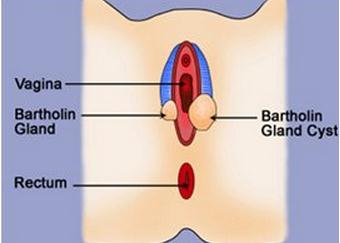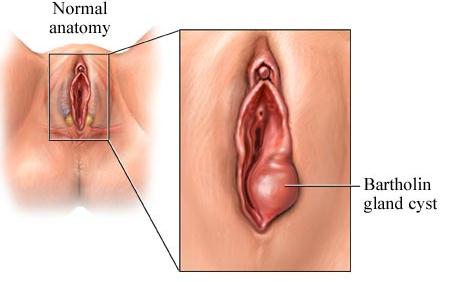Bartholin Gland Cyst – Pictures, Causes, Treatment
What are Bartholin Glands?
The Bartholin glands are two pea-sized glands located on the either side of the vaginal orifice under the skin. Bartholin glands are small enough which makes it non-palpable. One cannot see the Bartholin glands directly from the vulva because they are located under the tissues. Bartholin glands are also termed as Greater vestibular glands.
Bartholin glands were first described by a Danish anatomist, Caspar Bartholin the Younger during the 17th century. It was the discovery of the young Bartholin and not of his grandfather, Caspar Bartholin the Elder.
Functions
The Bartholin glands are essential during sexual intercourse. These two glands secrete mucus to lubricate the vagina during intercourse. It lubricates the outer genital area with fluids that come out of the Bartholin ducts into the opening of the vagina.
The mucus secreted by the Bartholin glands are relatively small and about one to two drops only. It is secreted when the woman is sexually aroused. The fluid also moistens the labia minora to make contact to the area less uncomfortable for the woman.
Bartholin gland Pathology
The Bartholin glands are sensitive to irritation and infection. Certain factors cause the ducts to become obstructed. When this happens, cysts may form and become infected. Infection of the glands and ducts may lead to abscess formation.
Cancer, tumors and hyperplasia of the Bartholin glands are rare.
What is Bartholin gland Cyst?
Obstruction in the duct causes fluid to build up because it is unable to be released to the vaginal opening. The formation of obstruction and fluid accumulation is termed as Bartholin gland cyst or Bartholin duct cyst.
Cysts that arise on the area are usually the size of a pea or marble. However, it can grow and form an abscess as a result of infection. Bartholin cyst are also usually painless and only one of the two ducts become affected.
Symptoms
Uncomplicated Bartholin gland cysts have the following symptoms:
- Painless lump on the vulva near the vaginal orifice
- Swelling and redness in the area
- Cyst may vary in size from a quarter of an inch to one inch. The cyst usually enlarges during sexual intercourse as a result of more fluid accumulating on the area.
- Dyspareunia (painful sexual intercourse). The woman may feel pain during intercourse as a result of irritation of the cyst and the absence of adequate lubrication resulting from the obstructed duct.
If Bartholin’s cysts become infected, the woman usually manifests the following symptoms:
- Pain. Severe pain on the cysts may be experienced and may result in difficulty walking and sitting.
- Abscess formation. Formation of pus in the area is a sign of an ongoing infectious process.
- Tenderness. Tenderness may be experienced on the surrounding areas of the cyst.
- Vaginal Discharges. Abnormal discharges may be present if the cyst is caused by a sexually transmitted disease.
- Fever. Fever is a sign of infection and some women may experience it.
Causes
Causes of Bartholin’s gland cysts vary, but they usually result from obstruction of the duct. These include:
Infection
Sexually transmitted diseases such as Chlamydia and gonorrhea cause the duct to become infected. Infection results in production of discharges that potentially blocks the duct. As a result, it causes fluid build-up and cyst formation.
Bacteria found on the intestinal tract such as Escherichia coli may also infect the duct and cause cyst formation.
Poor Personal Hygiene
Because of poor hygiene, infection may occur in the ducts and glands. Poor hygiene after sexual intercourse significantly increases chances of Bartholin’s gland cysts.
Use of restrictive pants and undergarments.
Restrictive clothing does not allow circulation of air and blood in the area and leads to blockage and cyst formation.
Diagnosis
Diagnosis of Bartholin’s gland generally involves physical examination of the vulva. Uncomplicated or uninfected cysts do not require special diagnostic tests.
In cases of infection, cultures and sensitivity testing of the abscess are done to determine the specific type of bacteria and the antibiotic treatment to be used. Smears of the vagina and cervix may also be done to determine presence of sexually transmitted diseases.
Treatment
Women with Bartholin gland cysts often seek treatment as a result of pain and difficulty walking or sitting. Some cyst resolve themselves, but others do not. Treatment of Bartholin cyst involves removal (surgery) and antibiotic use. Home remedies and prevention may also be instituted.
Antibiotic Treatment
Bartholin’s gland abscess requires antibiotic treatment to eradicate the causative microorganism. Antibiotics are in the form of penicillinns, cephalosporins or macrolides.
Hot sitz bath
Hot sitz bath involves the exposure of the vulva to hot steam to allow the abscess to be drained by itself. This also reduces pain sensations and hastens healing because of vasodilatation in the area that allows better blood circulation. This can be done at home by sitting in a tub with warm water for 15 minutes three times a day. Be sure not to use hot water because it may burn the skin and cause more damage.
Marsupialization
Marsupialzation involves a minor surgery to drain the abscess and remove the cyst. This is often done in an out-patient setting and does not require hospital admission. The procedure is done first by injecting local anesthetics around the surgical site. A small incision is made to drain the fluid and abscess. Next, the cyst wall is sutured to the skin to prevent the cyst from reccurring.
Marsupialization is often uncomfortable because local anesthetics often do not act well on the area. Depending on the choice of the patient and physician, sedation may be used.
Analgesics
Pain medications are usually prescribed to reduce pain as a result of the cyst or after surgical removal.
Prevention
Preventing cyst formation entails the following measures:
- Lower the risk for sexually transmitted diseases by using barrier protection such as condoms.
- Practice safe sex by practicing monogamy to prevent STDs
- Practice good perineal hygiene. These include perineal care, change of underwear, and change of napkins or tampons every two hours.
- Avoid using non-restrictive garments to allow for better circulation.
- Use cotton under garments. Cotton absorbs secretions well and prevents bacterial growth unlike satins and silk.
Complications
Complications do not usually develop; however, an infected cyst that is not treated may spread to underlying structures and may cause more extensive infection. Unremoved cysts through surgical treatment also often reoccurs. Malignancies are uncommon with Bartholin’s gland cysts.
Pictures

Image 1 – Bartholin Gland Cyst

Image 2 – Bartholin’s Gland cyst image

Image 3 – Bartholin Gland Drianage